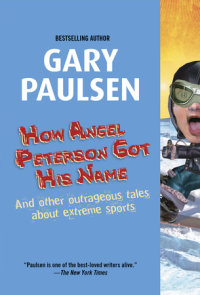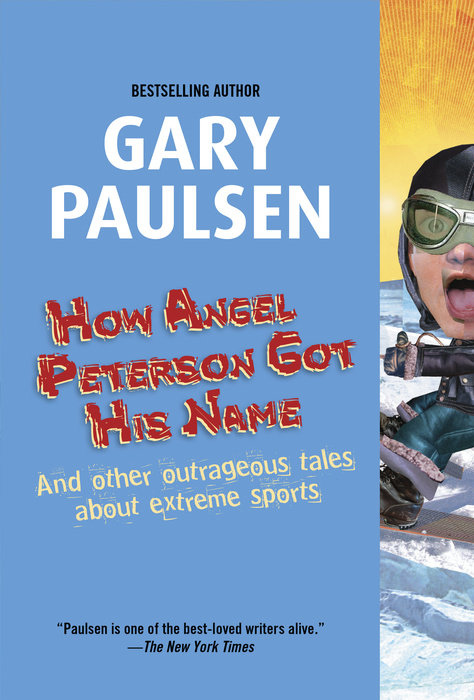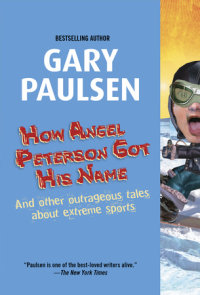1
How Angel Peterson
Got His Name
He is as old as me and that means he has had a life, has raised children and made a career and succeeded and maybe failed a few times and can look back on things, on old memories.
Carl Peterson--that's the name his mother and father gave him, but from the age of thirteen and for the rest of his life not a soul, not his wife or children or any friend has ever known him by that name.
He is always called Angel.
Angel Peterson, and I was there when he got his name.
We lived in northwestern Minnesota, up near the Canadian border and not far from the eastern border of North Dakota. The area is mostly cleared now and almost all farmland, but in the late forties and early fifties it was thickly forested and covered with small lakes and was perhaps the best hunting and fishing country in the world, absolutely crawling with fish and game. My friends and I spent most of our time in the woods, hunting, fishing or…
1
How Angel Peterson
Got His Name
He is as old as me and that means he has had a life, has raised children and made a career and succeeded and maybe failed a few times and can look back on things, on old memories.
Carl Peterson--that's the name his mother and father gave him, but from the age of thirteen and for the rest of his life not a soul, not his wife or children or any friend has ever known him by that name.
He is always called Angel.
Angel Peterson, and I was there when he got his name.
We lived in northwestern Minnesota, up near the Canadian border and not far from the eastern border of North Dakota. The area is mostly cleared now and almost all farmland, but in the late forties and early fifties it was thickly forested and covered with small lakes and was perhaps the best hunting and fishing country in the world, absolutely crawling with fish and game. My friends and I spent most of our time in the woods, hunting, fishing or just camping, but we lived in town and had town lives as well.
Because the area was so remote, many farms still did not have electricity, nearly none had phones and the rare ones that did were on party lines, with all users on the same line so that anybody could listen in to anybody else (called rubbernecking.) Individual phones were identified by the rings: two longs and a short ring would be one farm, two shorts and a long another farm and so forth. You would call somebody on a separate line by hand cranking a ringer on the side of your phone for the operator--one very long ring--and when she came on (it was always a woman) you would ask her to place your call, as in "Alice, I would like to talk to the Sunveldt farm over by Middle River," and the operator would ring them for you. Anybody on your own party line you would call by simply cranking their ring (my grandmother was a short, a long and a short).
In town we had private phones, with a clunky dial system that didn't always work, and that was about it.
There was--this is important--no television. There were just two channels in the major cities on the East and West Coasts. Almost nobody in town had a set. A TV set at that time was a huge buzzing, hissing black-and-white monster that had the added benefit of being dangerous. The coating on the inside of the picture tube required no less than forty-two thousand volts to operate, an amount that could easily kill fifteen or twenty horses. When television finally did come to the small towns up in Minnesota many a cat was turned into something close to a six-hundred-watt lightbulb by sticking his nose back in the power supply area of a console television set, trying to investigate the little crackling sounds and blue glow that came out of the ventilation holes. On his twelfth birthday, my pal Wayne Halverson licked the end of his finger and stuck it near the ventilation panel on his family's new RCA set. (Even though there was no television station programming to watch for nearly two more years they used it for a conversation piece and a place to put their bowling trophies, but my grandmother said the Halversons had always put on airs ever since Dewey, who was Wayne's great-great-grandfather, was kicked in the head by a workhorse and found that he could do accounting.)
Wayne never actually touched the top of the main rectifier tube and so didn't get the full jolt, which would have cooked him on the spot, but it arced over to his finger and a lesser charge, say enough to light two or three single-family dwellings for a week or so, slammed him back into the wall and left him unconscious for several minutes. He later claimed that the incident was what made him the only one in our group who could actually talk to girls.
Radio was king and every Sunday night we would go to the Texaco station where Archie Swenson worked and listen to Gunsmoke on the radio. Matt Dillon (played by William Conrad in the radio version) would say things like "I'm marshal of Dodge City, Kansas. It's a chancy kind of job and makes a man watchful and a little bit lonely but somebody has to do it." Archie let us buy bottles of Coca-Cola for a nickel and bags of peanuts to put in the Cokes for another nickel and sit and listen to the radio as long as we didn't bother him at work and most especially if we didn't bother him if any older high school girls came by for gas or just to flirt with him. We were all twelve and thirteen and in Archie's world not quite human.
Archie was very, very cool. He was sixteen and had a perfect ducktail haircut and worked at the Texaco station full-time because he'd dropped out of school. He wore Levi's pulled so low that if he hadn't worn a T-shirt tucked in you would have seen the crack in his butt. He smoked and kept a pack of cigarettes rolled into the sleeve of his T-shirt and as boys we worshiped him, and also, much more important for the story of Angel Peterson, Archie had a car.
For the times, it was a very hot car. It was a '39 Ford sedan with an original V-8 engine and even though it was well over ten years old, with years of rough use during the Second World War, when small-town cars had to double as trucks and sometimes even tractors, even so it was a fast car. But more, Archie had "done things" to the car to make it faster. We were too ignorant to know how, but we were sure he had chopped this or enlarged that or channeled here and ported there to make it more powerful, and V-8 Fords were known for their speed. Some could do well over eighty miles an hour. We had read about some hot rods that would do a hundred miles an hour but dizzying speeds like that were usually only achieved on racetracks. Archie's car was also cool because he had a knob on the steering wheel that was made of clear Plexiglas and had a picture of a partially nude woman imbedded in it.
Two more things have to be understood about those long-ago times before the stage is finally set for Angel.
First, that part of northern Minnesota is completely and unbelievably flat. During successive ice ages, it was scoured flat by glaciers bulldozing their way south. When the glaciers melted, the land became an enormous inland freshwater sea called Lake Agassiz, which later receded to form the Great Lakes.
The land is so flat that if you cut down the trees and paved the area, you could probably roll a bowling ball from northern Minnesota to Montana without half trying.
Second, without television the only news, outside newspapers, came once a week at the theater matinee, when we would watch something called newsreels, short black-and-white film clips of the week's events.
And so in mid-January of 1954, when the Minnesota winter had settled its icy hand on the north country, it came to pass that four of us, all thirteen years old, went to a Saturday matinee showing of a really interesting and informative film about how radiation from nuclear testing (known then simply as A-Bomb experiments) had caused a species of common ant to mutate and grow to be huge, forty-foot-tall monsters. The radiation also made the ants develop an overwhelming need to eat human flesh. The movie was called Them! and we all agreed it was well worth the fifteen cents' admission and the extra dime for popcorn and another nickel for a box of Dots.


